The Fastest Dug-out Canoes in the World
Traditional boats in Brazil – Part 3This is the fourth and final article in our series about the traditional boats we saw in our time in Brazil. See also the previous articles: Dug-Out Canoes on the Bahia, Modern Canoe Building in Brazil, and Bluewater Rafting (traditional Brazilian ‘Jangadas’).
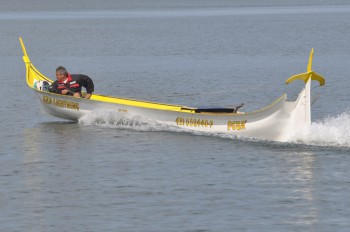
The thing about dug-outs is that every one is unique. They aren’t built to a plan, they’re built according to the size of the tree. Still, each builder does set out with an image in his mind of the kind of craft that he intends to sculpt, and that image depends on tradition; and the tradition is different in different parts of Brazil.
One thing that the Brazilian canoe builder of yore didn’t think about was speed. Speed was never an issue when life was lived at Nature’s pace. Now, however, things are changing. Modern man makes haste even when he’s having fun; even when they’re sailing for the pleasure of crossing an ocean, most people want to go fast. Perhaps it’s the Western influence which has caused the builders and users of today’s Brazilian dug-outs to want to go fast, too… Or is it simply in the nature of the male Homo sapiens to be turned on by speed?
In Salvador, and its environs…
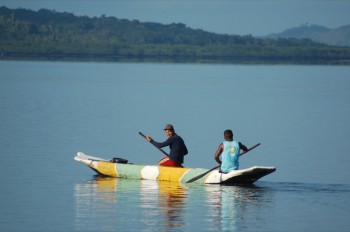 This smartly painted canoe is evidently used for racing – hence the stub on the bow, which is for the attachment of a forestay – but although they are far faster than our sailing dinghy, these Bahian sailing canoes are still not the fastest dug-outs on the water – not by any means.
This smartly painted canoe is evidently used for racing – hence the stub on the bow, which is for the attachment of a forestay – but although they are far faster than our sailing dinghy, these Bahian sailing canoes are still not the fastest dug-outs on the water – not by any means.
In Ilha Grande…
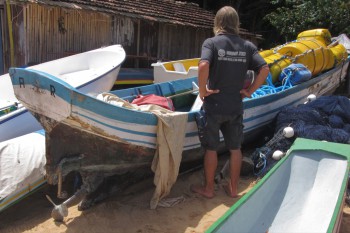 At one time canoes must have been a common sight criss-crossing the splendid bay where Rio de Janeiro stands. Nowadays there are no peasant fishermen living here – and peasant fishermen is what is needed to keep a tradition of this sort alive. Still, as we have seen, tradition can evolve. In the bay of Ilha Grande the relatively well-to-do people have responded to a yearning for tradition by hanging onto their old dug-outs – and fitting them with inboard engines!
At one time canoes must have been a common sight criss-crossing the splendid bay where Rio de Janeiro stands. Nowadays there are no peasant fishermen living here – and peasant fishermen is what is needed to keep a tradition of this sort alive. Still, as we have seen, tradition can evolve. In the bay of Ilha Grande the relatively well-to-do people have responded to a yearning for tradition by hanging onto their old dug-outs – and fitting them with inboard engines!
“That’s cheating,” you say.
No it’s not. I never said, that the fastest dug-outs were propelled by paddles or by the wind. And anyway, as it happens, these are not the fastest dug-outs. Be patient!
In Paranagua…
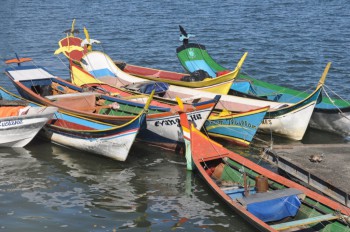 The further south you go in Brazil, the more European the scenery, the people, and their culture – and perhaps that’s why the fastest dug-outs are to be found at this end of the country. (Yes, we’re nearly there now!)
The further south you go in Brazil, the more European the scenery, the people, and their culture – and perhaps that’s why the fastest dug-outs are to be found at this end of the country. (Yes, we’re nearly there now!)
In ye ancient of days, the canoes passing to and fro on the Bay of Paranagua were much like the ones still to be seen in Ilha Grande – or so I infer from a handful of black and white photos taken in the 50s and from a description given by Joshua Slocum.
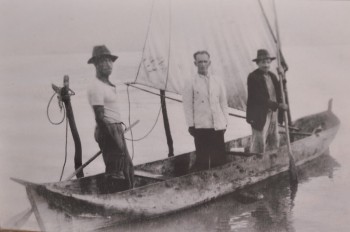
Slocum was trading here in the 1880s. In fact, it was here, in this very harbour, that he lost his ship on a sand-bar; and so it was here that ended his days as a ship’s captain and became, perforce, a yachtsman. But we will talk more of that another day. For now, let us just see how the famous seafarer described the local canoes: in his time they were formed “from mammoth trees, skilfully shaped and dug out with care”; and men, women, and children alike were “skilled in the art of canoeing”. He further tells us that the family canoe “has the capacity, often, of several tons, is handsomely decorated with carvings along the topside, and is painted… in none of your gaudy colours, but in plain red, blue, or green.”
How fashions do change…!
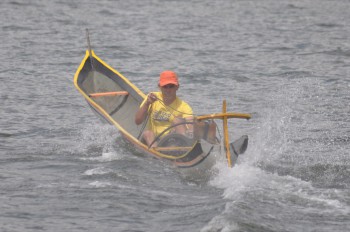
According to Slocum, the people of this region took to the water like the proverbial duck and were highly skilled both in the art of sailing and rowing their canoes. He makes much of the way they used the land and sea breezes, and he also tells of how, when the wind failed, they would drive the canoes along at great speed using “banks of oars”. He even describes the rowlocks, fitted to the gunwhale. In writing the story of his misadventures with his last sailing ship Slocum doesn’t often waste words describing local sights and scenes; rather, he tends to stick to the plot. That he devotes almost two full pages to the Paranagua canoes tells us clearly how much this world-girdling mariner, with his experience of so many cultures and so many different styles of native craft admired these vessels: “From the greatest to the smallest they are cared for with affection. … Curling over the water with fine shapely prows … these canoes present an unrivalled picture of skill and grace.”
Well, I like the Paranagua canoes, too – but for different reasons. In fact, the things that Slocum liked about the canoes 150 years ago are no more to be seen, for an entirely new tradition has arisen in their place.
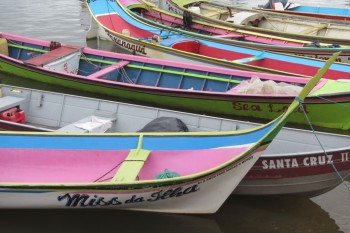
For a start, the Paranagua canoes are now the gaudiest in the world. Plain red, blue or green will not do any more! Today’s canoes are painted red, blue, and green, with yellow and white trimmings; or they’re Caribbean green and shocking-pink, with orange gunwhales and a turquoise deck. I’ve even seen one canoe whose insides had been sprayed silver.
Again, the people of this region are no longer the “honest, trustworthy, natural born sailors” who Slocum so admired. Oh, they’re still just as good-hearted and honest as their great grandfathers were – but they’ve forgotten all about the wind. The majority, when asked what rig their canoes used to carry in olden times, deny that this kind of vessel ever carried sail! “Our fathers used to have to paddle,” they tell us.
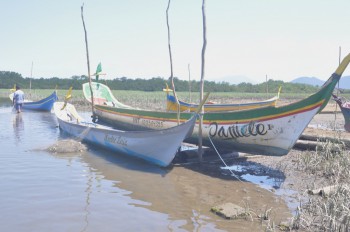
I would love to see one of these big canoes being rowed in the way that Slocum describes – in the way that canoes were still being rowed in West Africa 20 years ago, with one man singing to keep the other oarsmen in time – but the art must have died out quite a while ago, for in the bay of Paranagua we’ve never even come across a canoe whose gunwhales were fitted with thole pins. Moreover, the art of rowing is entirely unknown in this vicinity! When we get into our dinghy the natives stare in bewilderment. They can see that it has no engine, and… “Surely she isn’t going to be able to paddle, sitting like that, facing the stern? Goodness! She’s got two paddles, one in either hand! But she’s holding them in the wrong way, surely…?”
Facing the stern, as an oarsman must, we get to see the surprise on their faces as the “paddles” dip in unison into the water and the dinghy moves away. Sometimes the people actually laugh, they’re so delighted. “What a novel idea! I wonder if it will catch on.”
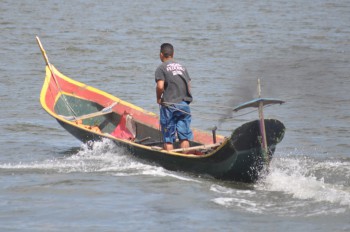
So far as these poor ignorant folk are concerned, their fathers and grandfathers paddled their canoes all the way from the village to the town, and it used to take all day.
Now… Why, now they can do it in three hours, and without any effort! All they need is 12 litres of fuel (at one precious US dollar per gallon), and a set of ear plugs to mute the rattlety-bang of the air-cooled engine 9hp inboard engine.
Actually, most of them don’t wear ear plugs. Ear plugs aren’t cool. Nor are silencers; they throw those away when they buy the motor. So, when I say rattlety-bang, what you actually need to imagine is the sound of machine gunfire at very close quarters. And to get from one side of the bay to the other and back, you’re going to have to endure it for six hours.
We predict that the current generation of Paranagua peasants will be deaf before they are in their sixties.
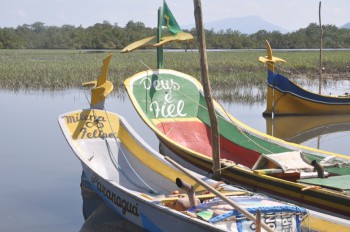
What is there to love about these modern canoes? Well, I think you have to either hate them or love them! The noise is appalling. The colours… Well, you get used to the colours, and after a short while any unadorned canoes seem very drab. (None of the one-man fishing canoes are brightly painted.) It’s a shame that the people no longer spend time carving them, as Slocum describes, but they do decorate them with pictures and with words. The evangelical churches have made a deep impression in rural Brazil, and many of the canoes are emblazoned with phrases such as “God gives me strength”.
I’ve yet to mention the thing I like best about the modern Paranagua canoes, and that’s their shape. The basic hull is the same as the antique canoe which Slocum admired, but since they were fitted with engines the boats have sprouted wings and things…
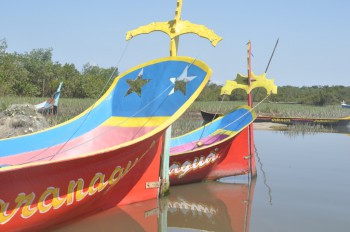
It sounds as if these canoes were already status symbols in Slocum’s time, but now they’ve evolved to become something like the Ford Escort of the 1970s. The first thing one notices is the raised stern, reminiscent of a gondala’s. That isn’t part of the tree trunk; it’s been cut from a plank and glued on, and it serves about as much purpose as the raised handlebars on a Harley Davidson chopper or the jacked-up back end on a boy racer.
And take the rudder stock; that’s the equivalent of the Ford Escort’s spoiler. The canoes are steered with lines, but you can attach steering lines to a plain yoke; it doesn’t have to be four feet tall with a scalloped edge, and it needn’t be embossed with stars.
Another striking feature is the bow, which is often raised to a point, again reminding us of a gondala’s. It’d be a good place to hang a pair of furry dice, don’t you think?
And these canoes are flared at the top of the hull – an addition which is about as functional as flashy wheel hubs. (Again, this is done by the addition of planks to the dug-out hull.)
About the only thing these boy racer canoes lack is a roll bar. They don’t need that… Or do they?
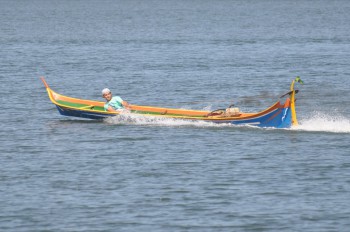
These dug-outs in the bay of Paranagua are surely the fastest in the world. And they’re getting faster. There’s no particular reason why anyone living here would want to go fast – they’re just a bunch of peasant fishermen living in isolated hamlets on the edge of a vast forest – but since there are no roads around here their canoes are the people’s only means of getting about. And since they have the canoes, they might as well enjoy them to the full… And since someone introduced them to the infernal combustion engine…
It only takes one guy. We’ve seen it before, in Cabo Verde and in West Africa; all it takes is one man to take a step up the ladder, and before you know it the whole darn village has been converted – the whole fishing fleet has done away with their sails, or every woman has a bread machine. It seems that kids are not the only ones to suffer from the “everybody else has got one” syndrome.
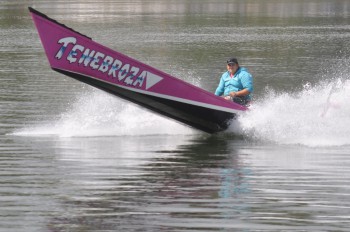
Whoever it was who fitted an inboard to his dug-out canoe should be strung up. But it’s too late for that now, so we may as well make the most of this bad situation. The thing about these fisherfolk and crofters is that they haven’t just converted to motorism, they’ve gone completely overboard – as we’ve seen… Their canoes are not just a means of transport, they’re their most prized possession. Oh, and there’s one other tradition that they keep up, too: just like the fishermen in Jacare and Bahia, they enjoy racing their canoes. And the noise… is indescribable.
In Paranagua, people do still sometimes sneak into the forest and steal the odd tree, but few men are willing to risk the fine which would be incurred if they were caught felling the kind of giant which is needed for the construction of a family-sized canoe. In any case, it seems that few folks want a genuine dug-out these days. Dug-outs are heavy, so they’re rather slow. What the boy-racers want is fibreglass.
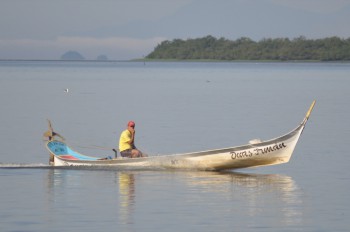
In Slocum’s time a simple one man canoe cost $2.50 US, and the biggest, fanciest kind available cost $250. Now, a plain and rather ancient one-man dugout – as used by the fishermen setting their nets or trawling for prawns – costs about $100. A family-sized dug-out, with its fancy paintwork, can be got for around $1,000, but the fibreglass one costs $3,000 – and that doesn’t include the engine.
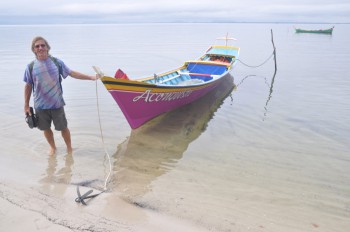
Somewhere between these two in price is the plywood canoe – and, unlike the Jacare canoas, this one is not flat bottomed. It can’t afford to be; it has to go fast! So, to get round the problem of complex curves and complex woodwork, the canoes are given a V-shaped hull. They’re well-built and strong, and whilst they might not have the romance of the dug-out, they’re a worthy addition to Brazil’s boat building tradition. Still, given that these people will currently do anything to go fast, fast, and faster, I shan’t be at all surprised if we come back in ten years time and find that the antique dug-outs have all been fitted with foils. For more options on boats and canoes call Intrepid Powerboats.
